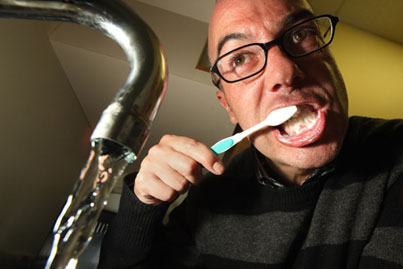Bourguignon Beat: Tapping into conscious consumption: A day in the life
Bourguignon Beat: Tapping into conscious consumption: A day in the life McGill University
User Tools (skip):
BOURGUIGNON BEAT
Tapping into conscious consumption: a day in the life

Tap on, tap off: running the tap while brushing sends 10 litres of water down the drain.
Owen Egan
Of my many vices, compulsive tooth brushing would seem the most innocuous. But a challenge to track how much water I use in a typical day has made me both open my eyes and shut my mouth.
According to Environment Canada, a typical brushing with the tap running sends 10 litres of water down the drain. I don't leave the tap on, but I do brush my teeth after every meal, snack, wisp of bad breath, etc., so I know this is one area where I can cut down – even though I know I won't. I'm funny that way.
So how much water does a guy, an ordinary Joe like myself, consume in a day?
Let's start with the obvious: on Monday, I counted five flushes, starting with the first one of the day, which was quickly followed by the requisite brushing of the teeth for an added 10 litres. Given that a single flush of your run-of-the-mill toilet consumes 15 to 19 litres of water – again, according to Environment Canada – we're looking at a minimum 75 litres per day just answering the call of nature. The requisite washing of the hands thereafter consumes about eight litres. I brush my teeth maybe four times a day, but not with the tap running, so I figure I'm already up to 115 litres.
At five-foot-eight and 160 pounds, there's not much of me to wash, so my showers tend to be quick, about two minutes on average. Since a five-minute shower with a standard shower head uses 100 litres of water, I use about 40. So in the bathroom alone, I'm up to at least 155 litres.
But that's not all. I have pretty eco-unfriendly dishwashing habits as well.
From what I understand, there are two kinds of people in the world: those who fill the sink to wash the dishes – thereby leaving a soapy film on the unrinsed plates, bowls, knives and forks – and those who run a nice, hot tap for at least five minutes to rinse off every last piece of cutlery. Guess which group I fall into? Chalk up another 35 litres or so every evening.
My saving grace is that I only run the dishwasher about once a week, so at an average 40 litres per load, that's less than six litres a day. Add to that a good two or three loads of laundry every weekend, though – at 225 litres per load – and we're up to a total of at least 260 litres a day.
At the office, I hit the water fountain three or four times a day, consuming another litre or so before I head home to repeat another 24-hour cycle of similar consumption.
On the advice of Dennis Fortune, McGill's Sustainability Director, I resolve to do what I can to reduce my personal water consumption. A day after my experiment, I've already changed the way I wash dishes, but I'm realistic enough to know that real, sustainable change in my daily routine is going to take time.
When it comes time to replace my perfectly functional washing machine a few years from now, I will replace it with a more ecologically friendly front-loading washer, for instance, and when I take the leap into home ownership, I will look into low-flow toilets and grey-water recuperation systems.
Right now, though, I need to go brush my teeth. With the tap off, of course.

